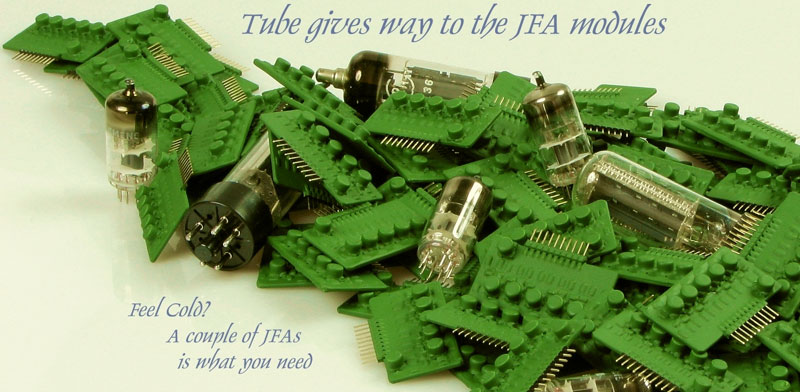|
Why JFA is a class
A Amplifier? What is a class A amplifier? A class A amplifier is defined as one which is biased to a point where plate or drain current flows for the entire swing of the input signal between the cut off and saturation. This is done by biasing the stage around the middle of its course between cut off and saturation points. More exactly the stage should be biased to dissipate the max power with no input signal, but sometime to centre the linearity of the transfer curve the bias point is shifted from the max dissipation point. The JFA has six single ended Jfet stages working in this way. The sixth stage has no gain; it simply acts as phase inverter of the signal already available at PIN 8. . Why does JFA generate even harmonics?
It is known that tubes and Jfets use the same working principle. In
the tube a negative voltage interferes with the flow of electrons
running in the vacuum from the cathode to the plate, thus modulating
the current flow in the tube. In the Jfet the same negative voltage
interferes with the flow of electrons running in the silicon from
the source to the drain, thus modulating the current flow in the
Jfet. Tubes and Jfet exhibit the same smoothed shape transfer
characteristic curves. Transistors, on the other hand, have an
abrupt transfer characteristic curve with a threshold knee around
0.7 V. Tubes and Jfet produce even harmonics if used in a single
ended stage, while in a push pull stage the even harmonics are
cancelled. What do we mean for class A and pure class A?
Once a single ended stage has to be biased two modes are available;
self bias using a cathode/source resistor, or fixed bias, using a
negative bias voltage and grounding the cathode or the source. The
first way is the most widespread while the second is especially used
in guitar power amplifiers where a negative feedback is often
applied from the output to the input stage. The JFA uses self biased
stages using a particular Rdrain/Rsource ratio. This guarantees a
stable gain & bias and low distortion. This is what we mean by class
A and it should serve to satisfy all HI FI guys, but could leave
some music guy less happy, so:
Some notes about
operational amplifier. |
|
|
|
|
